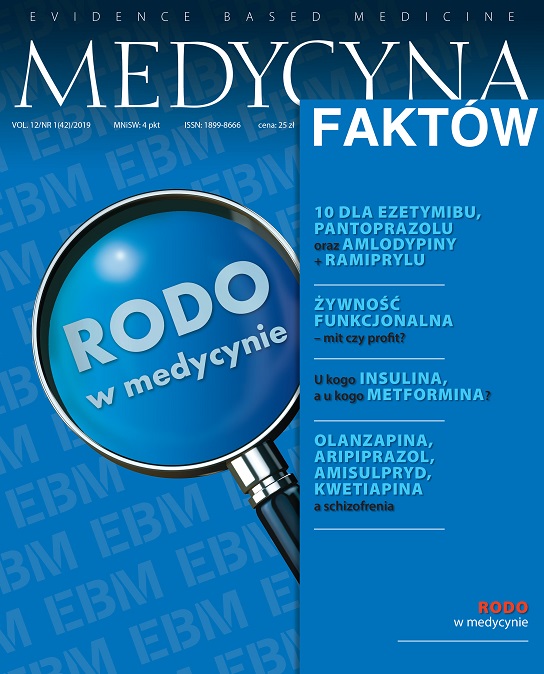Ten benefits of using fixed-dose combination of ramipril and amlodipine in hypertension Review article
Main Article Content
Abstract
Fixed-dose combinations of antihypertensive drugs in a single pill gain increasing popularity in treatment of arterial hypertension due to the benefits in terms of improvement in patient’s persistence and compliance. Ramipril and amlodipine are marked with favorable results from large clinical trials, both in uncomplicated hypertension as well as in hypertension with cardiovascular complications.
Article Details
How to Cite
Kostka-Jeziorny , K., & Tykarski , A. (2019). Ten benefits of using fixed-dose combination of ramipril and amlodipine in hypertension. Medycyna Faktow (J EBM), 12(1(42), 69-74. https://doi.org/10.24292/01.MF.0119.12
Issue
Section
Articles
Copyright © by Medical Education. All rights reserved.
References
1. Agabiti-Rosei E., Ambrosioni E., Dal Palu C. et al.: ACE inhibitor ramipril is more effective than the beta-blocker atenolol in reducing left ventricular mass in hypertension. Resultsof the RACE (Ramipril Cardioprotective Evaluation) study on behalf of the RACE study group. J. Hypertens. 1995; 13(11): 1325-1334.
2. Lonn E.M., Yusuf S., Dzavik V. et al.: Effect of ramipril and vitamin E on atherosclerosis: the study to evaluate carotid ultrasound changes in patients treated with ramipril and vitamin E (SECURE). Circulation 2001; 103: 919-925.
3. The Acute Infarction Ramipril Efficacy (AIRE) Study Investigators: Effect of ramipril on mortality and morbidity of survivors of heart failure. Lancet 1993; 342: 821-828.
4. Heart Outcomes Prevention Evaluation (HOPE) Study Investigators: Effects of ramipril on cardiovascular and microvascular outcomes in people with diabetes mellitus: results of the HOPE study and MICRO-HOPE substudy. Lancet 2000; 355: 253-259.
5. Williams B., Mancia G., Spiering W. et al.: 2018 ESC/ESH Guidelines for the management of arterial hypertension. The Task Force for the management of arterial hypertension of the European Society of Cardiology (ESC) and the European Society of Hypertension (ESH). Eur. Heart J. 2018: 1-98.
6. Deanfield J.E., Detry J.M., Lichtlen P.R. et al.: Amlodipine reduces transient myocardial ischemia in patients with coronary artery disease: double-blind Circadian Anti-Ischemia Program in Europe (CAPE Trial). J. Am. Coll. Cardiol. 1994; 24(6): 1460-1467.
7. Nissen S.E., Tuzcu E.M., Libby P. et al.: Effect of antihypertensive agents on cardiovascular events in patients with coronary disease and normal blood pressure: the CAMELOT study: a randomized controlled trial. JAMA 2004; 292(18): 2217-2225.
8. Kramsch D.M., Sharma R.C.: Limits of lipid-lowering therapy: the benefits of amlodipine as an antiatherosclerotic agent. J. Hum. Hypertens. 1995; 9(supl. 1): S3-9.
9. Mason R.P., Kubant R., Heeba G. et al.: Synergistic effect of amlodipine and atorvastatin in reversing LDL-induced endothelial dysfunction. Pharm. Res. 2008; 25(8): 1798-1806.
10. Levine C.B., Fahrbach K.R., Frame D. et al.: Effect of amlodipine on systolic blood pressure. Clin. Ther. 2003; 25(1): 35-57.
11. Calvo C., Gude F., Abellan J. et al.: A comparative evaluation of amlodipine and hydrochlorothiazide as monotherapy in the treatment of isolated systolic hypertension in the elderly. Clin. Drug Investig. 2000; 19(5): 317-326.
12. Julius S., Kjeldsen S.E., Brunner H. et al.: VALUE trial: Long-term blood pressure trends in 13,449 patients with hypertension and high cardiovascular risk. Am. J. Hypertens. 2003; 16(7): 544-548.
13. Makani H., Bangalore S., Romero J. et al.: Effect of renin-angiotensin system blockade on calcium channel blocker-associated peripheral edema. Am. J. Med. 2011; 124: 128-135.
14. Miranda R.D., Mion D. Jr., Rocha J.C. et al.: An 18-week, prospective, randomized, double-blind, multicenter study of amlodipine/ramipril combination versus amlodipine monotherapy in the treatment of hypertension: the assessment of combination therapy of amlodipine/ramipril (ATAR) study. Clin. Ther. 2008; 30: 1618-1628.
2. Lonn E.M., Yusuf S., Dzavik V. et al.: Effect of ramipril and vitamin E on atherosclerosis: the study to evaluate carotid ultrasound changes in patients treated with ramipril and vitamin E (SECURE). Circulation 2001; 103: 919-925.
3. The Acute Infarction Ramipril Efficacy (AIRE) Study Investigators: Effect of ramipril on mortality and morbidity of survivors of heart failure. Lancet 1993; 342: 821-828.
4. Heart Outcomes Prevention Evaluation (HOPE) Study Investigators: Effects of ramipril on cardiovascular and microvascular outcomes in people with diabetes mellitus: results of the HOPE study and MICRO-HOPE substudy. Lancet 2000; 355: 253-259.
5. Williams B., Mancia G., Spiering W. et al.: 2018 ESC/ESH Guidelines for the management of arterial hypertension. The Task Force for the management of arterial hypertension of the European Society of Cardiology (ESC) and the European Society of Hypertension (ESH). Eur. Heart J. 2018: 1-98.
6. Deanfield J.E., Detry J.M., Lichtlen P.R. et al.: Amlodipine reduces transient myocardial ischemia in patients with coronary artery disease: double-blind Circadian Anti-Ischemia Program in Europe (CAPE Trial). J. Am. Coll. Cardiol. 1994; 24(6): 1460-1467.
7. Nissen S.E., Tuzcu E.M., Libby P. et al.: Effect of antihypertensive agents on cardiovascular events in patients with coronary disease and normal blood pressure: the CAMELOT study: a randomized controlled trial. JAMA 2004; 292(18): 2217-2225.
8. Kramsch D.M., Sharma R.C.: Limits of lipid-lowering therapy: the benefits of amlodipine as an antiatherosclerotic agent. J. Hum. Hypertens. 1995; 9(supl. 1): S3-9.
9. Mason R.P., Kubant R., Heeba G. et al.: Synergistic effect of amlodipine and atorvastatin in reversing LDL-induced endothelial dysfunction. Pharm. Res. 2008; 25(8): 1798-1806.
10. Levine C.B., Fahrbach K.R., Frame D. et al.: Effect of amlodipine on systolic blood pressure. Clin. Ther. 2003; 25(1): 35-57.
11. Calvo C., Gude F., Abellan J. et al.: A comparative evaluation of amlodipine and hydrochlorothiazide as monotherapy in the treatment of isolated systolic hypertension in the elderly. Clin. Drug Investig. 2000; 19(5): 317-326.
12. Julius S., Kjeldsen S.E., Brunner H. et al.: VALUE trial: Long-term blood pressure trends in 13,449 patients with hypertension and high cardiovascular risk. Am. J. Hypertens. 2003; 16(7): 544-548.
13. Makani H., Bangalore S., Romero J. et al.: Effect of renin-angiotensin system blockade on calcium channel blocker-associated peripheral edema. Am. J. Med. 2011; 124: 128-135.
14. Miranda R.D., Mion D. Jr., Rocha J.C. et al.: An 18-week, prospective, randomized, double-blind, multicenter study of amlodipine/ramipril combination versus amlodipine monotherapy in the treatment of hypertension: the assessment of combination therapy of amlodipine/ramipril (ATAR) study. Clin. Ther. 2008; 30: 1618-1628.

